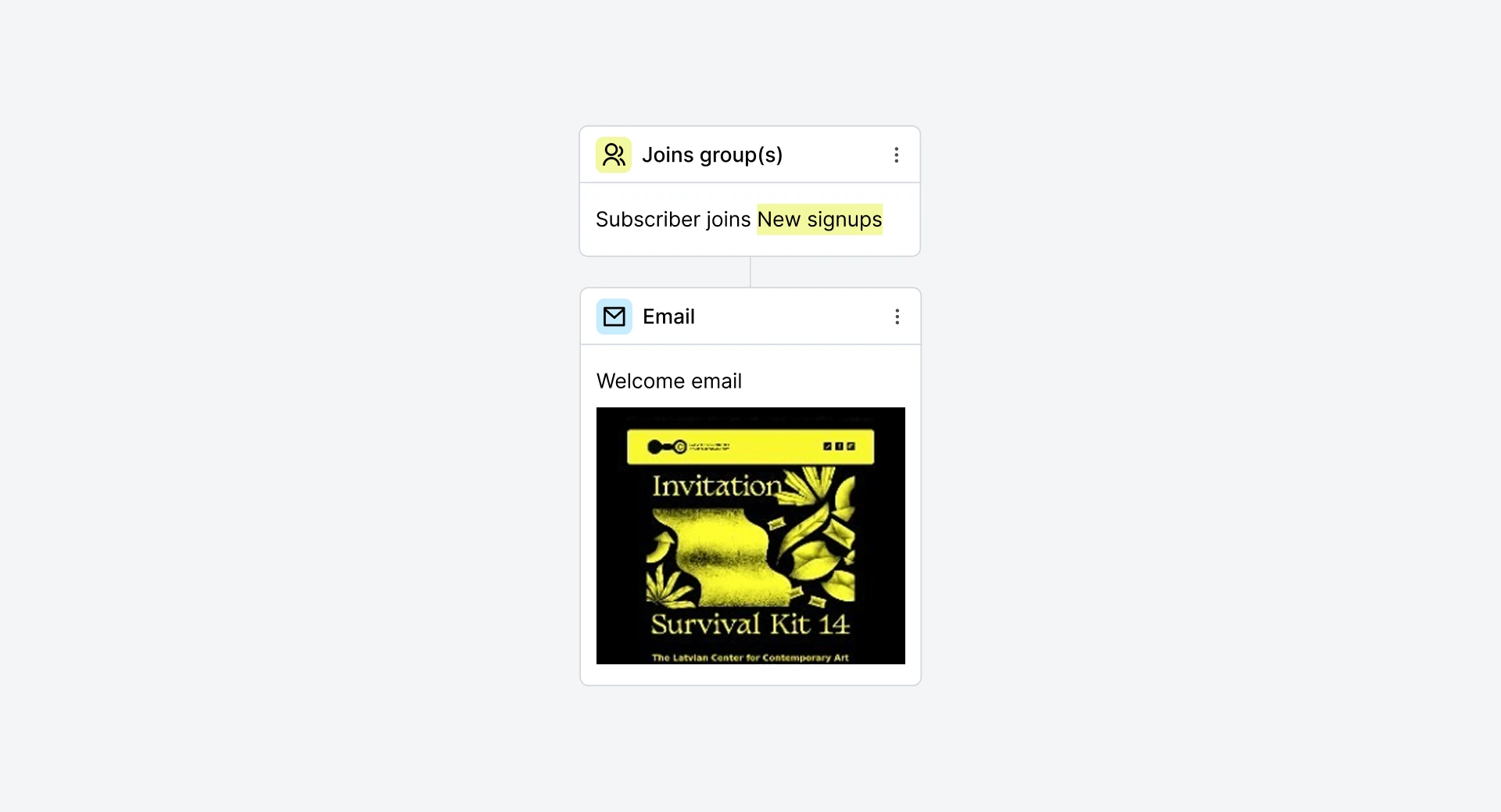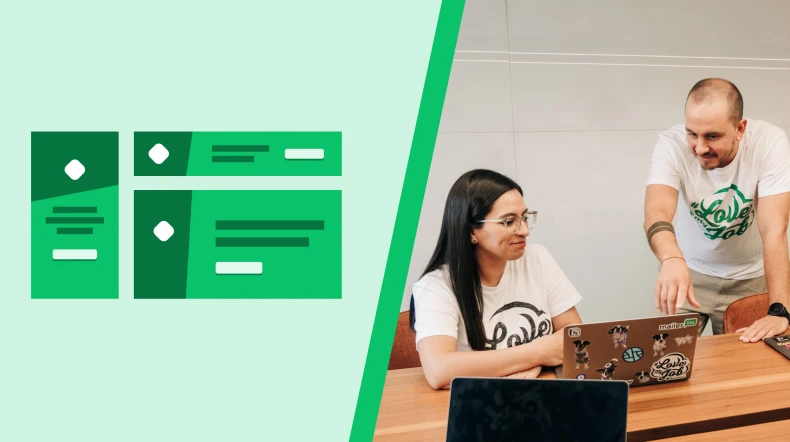How to create a personalized email marketing strategy for more engagement and sales
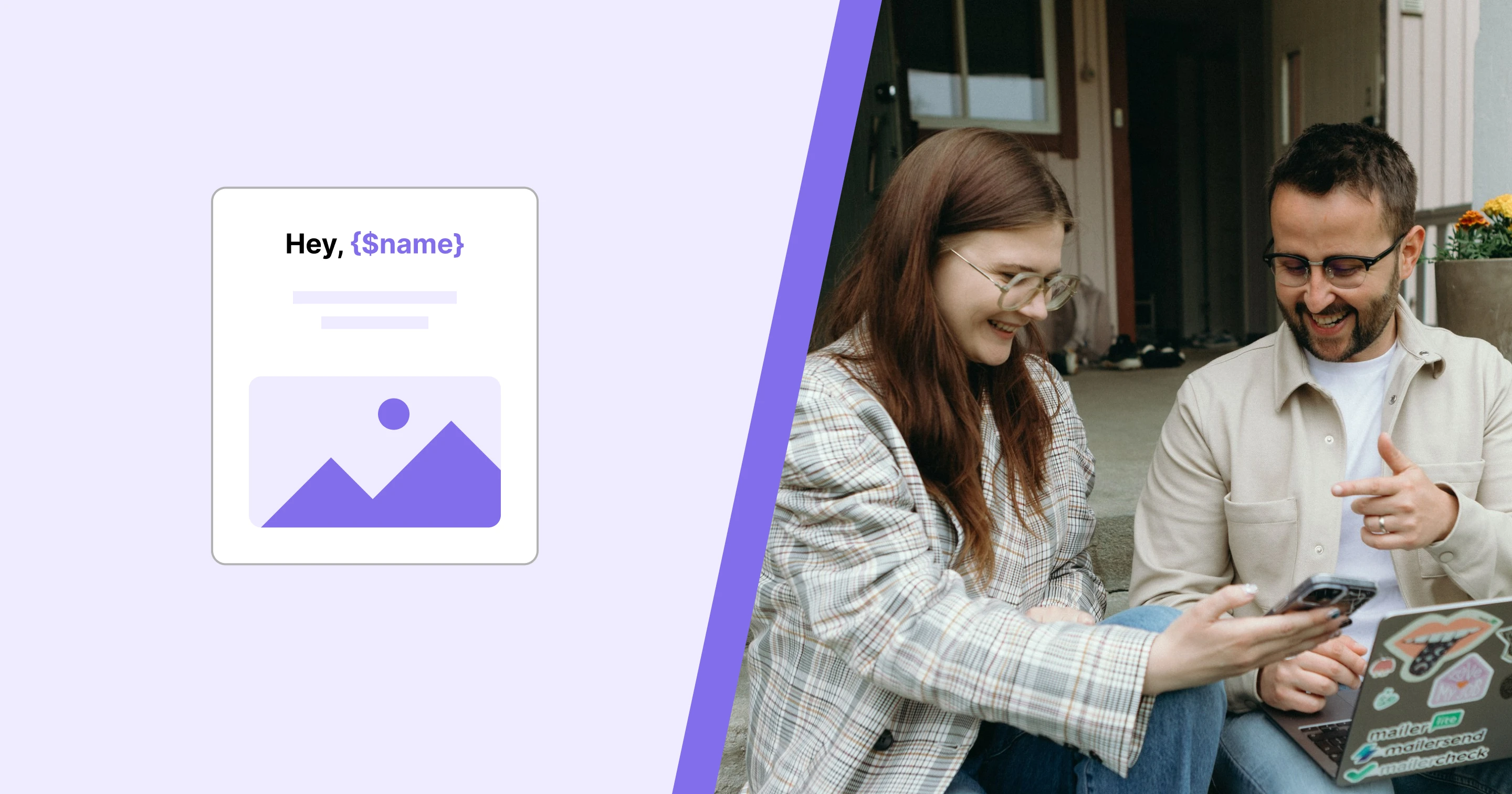
Personalized emails get results! Our research shows that targeted campaigns see 36.69% more opens and 267.21% more clicks—because they give subscribers what they want.
To make your emails more personal, you need to do 2 things:
Learn useful data about your subscribers.
Send content tailored to them.
MailerLite has the tools to help. In this guide to personalized email marketing, we'll share how to create personalized campaigns, smart ways to collect the data you need, example emails, and more.
What are personalized emails?
Personalized emails are messages tailored to individual recipients based on data you have about them such as name, location or behaviors. Instead of sending the same message to everyone, personalized emails adjust the content to make it relevant and engaging for each person.
Here are some quick ways you can personalize email content:
Personalize the subject line: Add the recipient’s name to the subject line to catch their attention
Personalize the delivery time: Use engagement or location data to send emails at the perfect time
Personalized email content: Use dynamic blocks to add content that only specific subscriber groups or profiles can see
Send targeted campaigns: Send specific campaigns to people based on groups, segments, email engagement, location or many other factors
Automation messages: Email automation lets you send messages based on specific subscriber behavior. This ensures they receive content that is tailored to their exact needs
See the screenshot below for an example of an email that uses the subscriber's name in the copy.
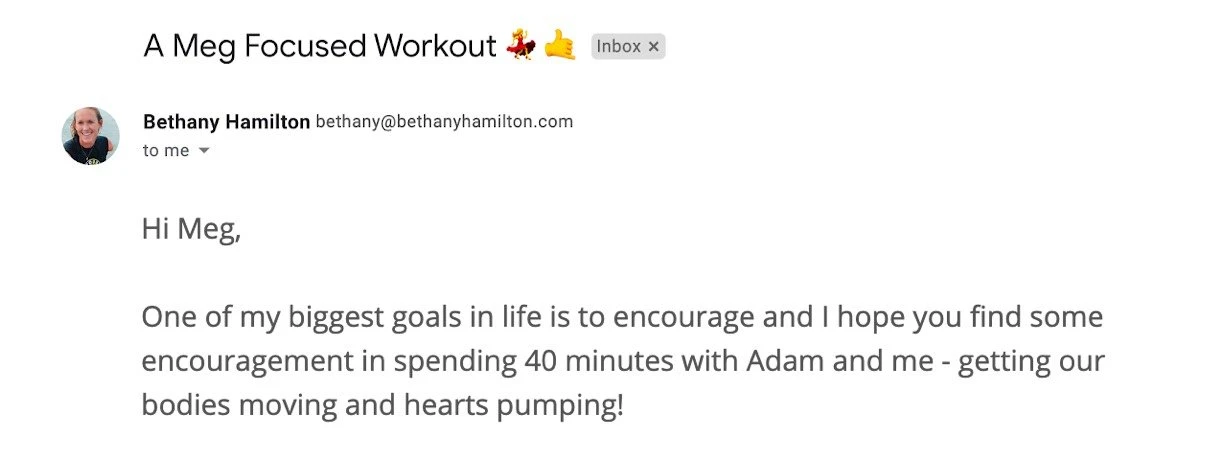
Emails targeted towards a particular customer’s needs often get higher open rates, more clicks, and better conversions because they feel more relevant to the person receiving them. Instead of a generic broadcast, it feels like a message made just for them.
8 personalized email marketing strategies
Here are 8 email marketing strategies to send personalized messages. They focus on everything from the email content to the timing of the messages. And remember, you can use multiple strategies at once to create even more tailored messages.
1. Add custom variables to email copy for a personal touch
Thanks to MailerLite’s subscriber fields, you can personalize your email copy by adding text that changes for each subscriber.
A common way to use this feature is to collect the subscriber’s name and then add it to the email content. Here are some ways you could use this:
Email subject line: Add the recipient’s name to the subject line to make your email stand out in cluttered inboxes.
Email preheader: Emails with custom preheaders get 23% more opens. Take this further by adding their name or interests to the preheader.
The intro section: Add the subscriber’s name to the first line. Instead of saying, “Hey subscriber,” your email will say “Hey [subscriber’s name]”
Email postscript: The P.S. section of an email is a good way to draw attention to an offer. Add a personal touch here to make it more effective.

MailerLite has 9 default fields that you can use: Name, Last name, Email, Phone, Company, Country, State, City, and Zip.
You can also create custom fields to store any kind of data that is useful to your business. Each field gets its own variable that you can add to your email content via the Insert personalization button or by copying and pasting the tag into the relevant spot.
Some subscribers won’t have the relevant information in their profile. Add a fallback term by adding |default(value) to the field. For example, show the word “friend” when there’s no name using this tag {$name|default(friend)}.
The email will show either:
Hey [name] if they have a name saved in their profile
Hey friend if they don’t have a name saved in the profile
Learn more about adding variables to your emails in Mailerlite here.
2. Personalize email content with dynamic blocks
With MailerLite’s dynamic content, you can show different content to different recipient groups from the same email.
Head to the relevant block’s visibility settings and choose to either show or not show the content to a set of subscribers.
Here are 4 ways you can use this feature to create more personal experiences:
Show relevant product recommendations
Use the information in your subscribers' profiles to recommend products that are relevant to their interests. This could be based on purchase history, link clicks or other collected data.
For example, the Guide to email marketing in the image below will only be shown to people who are tagged as interested in email marketing.
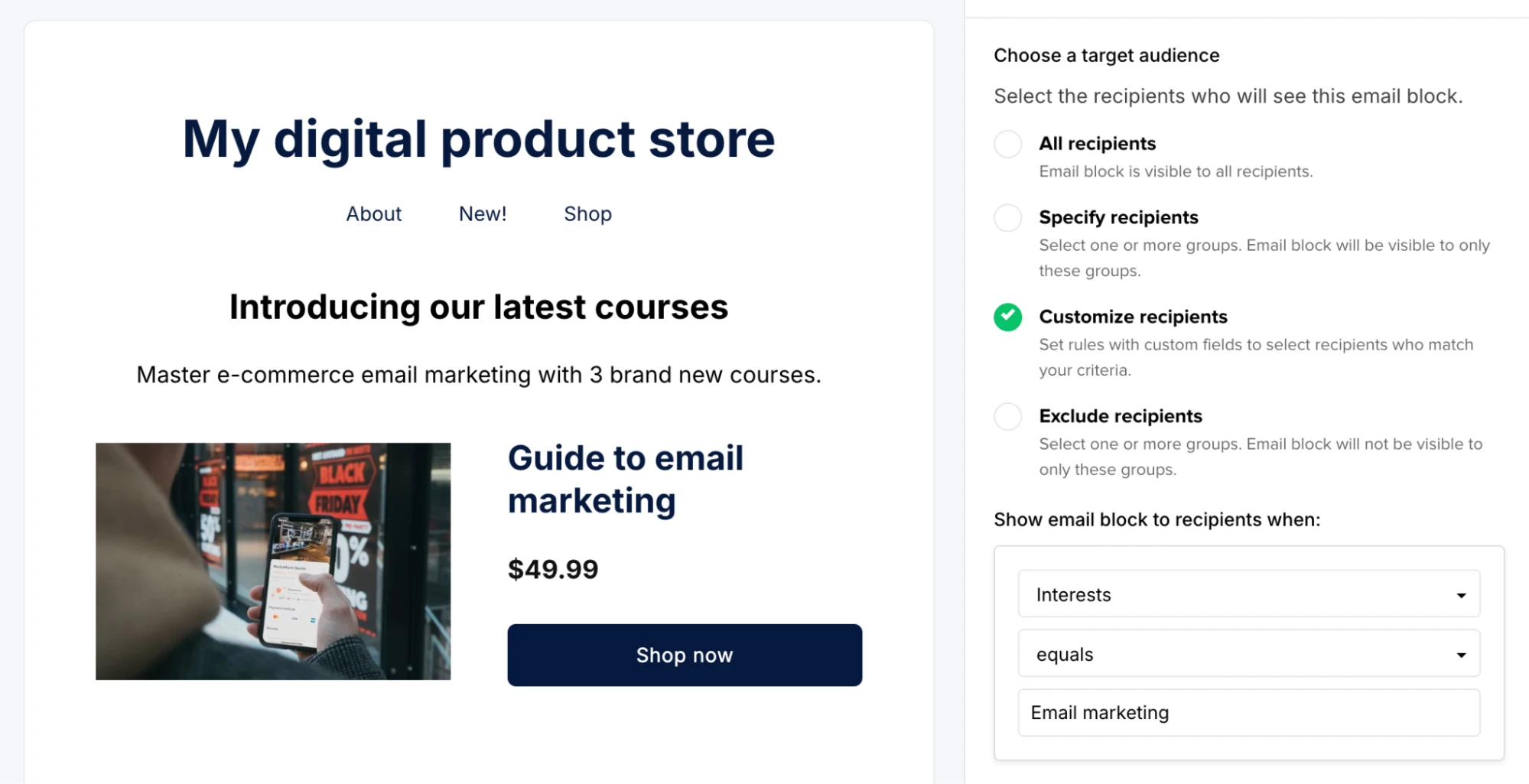
Show different offers to different subscribers
Customers are more likely to react positively to offers that are tailored to their needs. You can use dynamic content settings to show targeted offers.
A subscription service could:
Show a free trial to people who haven’t bought yet
Show an annual discount to monthly customers
Show high-ticket service upsells to annual customers
With this in place, each group will receive an offer relevant to their stage of the customer journey.
Tailor messaging to different groups
Another option is to use a single offer, such as a 20% discount, but change the messaging so it appeals to different groups.
For example:
People yet to buy: 20% off their first purchase
Existing customers: 20% off their next purchase
Customers with over 5 buys: A thank you for your loyalty 20% off gift
Think about ways to frame your offer so it appeals to specific types of recipients.
Show relevant nurture content
Campaigns are a great way to nurture leads with educational content. Go a step further by sharing content that helps with the exact goals customers are struggling with.
For example, both e-commerce stores and creators use MailerLite. We could show a guide to e-commerce email marketing to the former group, and a guide to growing your creator brand with email marketing to the latter.
3. Personalize the delivery time
A simple way to personalize your email is to send it at optimized times. MailerLite has 2 ways you can achieve this.
Send by timezone sends the email at the same local time to all recipients. Someone in San Francisco and someone in Seoul both get the email at the target time, even though there is a 16-hour time difference between the 2 cities.
The other option is Smart sending. This analyzes a subscriber's past email interaction to identify when they are most likely to engage with your content. It then automatically sends the email to each subscriber at the best time.
You can choose to use either of these features in the Review and schedule section of your campaign. See the options in the screenshot below.

4. Send a birthday or anniversary email
With MailerLite’s The anniversary of a date automation trigger, you can send an email on, before or after the anniversary of a date saved in the customer profile.
Here are 2 common ways to use this trigger:
E-commerce stores can collect subscribers' birthdays and send a discount coupon the week before their big day. This keeps customers happy while increasing the chances that they make a repeat sale.
Subscription businesses can send an email in the time before a subscriber's plan expires, reminding them that their renewal date is approaching. This ensures they aren’t caught by surprise by the money leaving their account.
Combine this with other personalization strategies mentioned in this article, like adding the recipient's name or recommending relevant products.
5. Use email automation to send the right message to the right people
Automated emails provide the information a subscriber wants at the exact time they want it, making them a powerful form of personalization.
Targeting emails in this way can be extremely effective: the average open rate and click-through rates for the first email in an automation for e-commerce stores is 64.03% and 21.32%, respectively, far higher than the average for general campaigns, which is 41.73% and 6.69%.
The key is to create triggered emails that send the information customers want at the moment they want it.
A common example is a welcome email that provides more information about your brand at the moment the customer signs up. These emails can generate very high customer engagement since the customer is poised to hear more from you.
In fact, e-commerce store Hyggekrog’s welcome email has an astonishing open rate of over 90%! The email provides more information about the store, its loyalty program and a code the buyer can use to get a 10% discount on their first purchase.
6. Recommend relevant products to get more sales
Make your product recommendations personal by highlighting more relevant items. Use data you have about the customer to make an educated guess at what they might like.
Data you can use includes:
Links they clicked: If someone clicked on a link to a particular product, they may be interested in similar items
Products they bought: If someone bought men’s clothing, it makes sense to send more men’s clothing recommendations
Location: Send Mother’s Day product recommendations to people in the U.S. in May and people in the U.K. in March
Total spend: Send lower-cost products to people who are yet to buy, and higher-cost items to existing customers who already trust your brand
Once you have relevant information, either send campaigns filtered to each group or send a single email and use the product block’s dynamic settings to show the targeted recommendations.
As well as personalization, there are plenty of things you can do to boost conversion rates.
Here are some of them:
Create a sense of urgency with limited-time offers
Add customer testimonials and social proof to messages
Optimize your call-to-action text and color
Adjust your pricing and offers
Finally, test all the above factors by using A/B testing to see what works and closely tracking your email metrics.
7. Personalize content based on store interaction
Thanks to segments and automations, you can send targeted messages based on someone’s shopping behavior, such as when they buy from your brand.
E-commerce store Fridja sends a post-purchase email that includes help and guides that are relevant to the specific product purchased. You could also use a purchase as an opportunity to upsell other products.
Another type of email based on shopping behavior is abandoned carts. These messages go out when a logged-in user adds a product to their cart but fails to buy. The message includes a reminder and a link to the exact product the customer was about to purchase.
8. Personalize based on behavioral triggers
You can personalize the information in an email based on brand engagement. This ensures that people get emails that are relevant to the specific ways they interact with your brand.
For example, Pathpages sends a follow-up email to those who show interest in a specific product by clicking on it. This email includes more information about the product they showed, as well as a discount.
Other ways you could personalize content based on brand engagement include when the customer:
Signs up for a webinar
Downloads a lead magnet or resource
Completes a website form
Signs up for a free trial
The key is to identify key points and then send the most relevant content.
Fire up your personalization strategies with data collection
To effectively personalize your emails, you first need to collect information about your subscribers.
Here are 6 ways you can do this, both by automatically tracking customer interaction and by asking customers to provide details.
1. Collect info in sign-up forms
A super simple way to collect customer info is to ask for it when people subscribe to your newsletter via an email signup form.
With MailerLite’s form builder, you can add custom fields to your form that correspond to a field in the customer's profile.
You can let people enter text, which is useful for customer data like names, or you can let people choose from prespecified options, which is useful for gathering interests or industries.
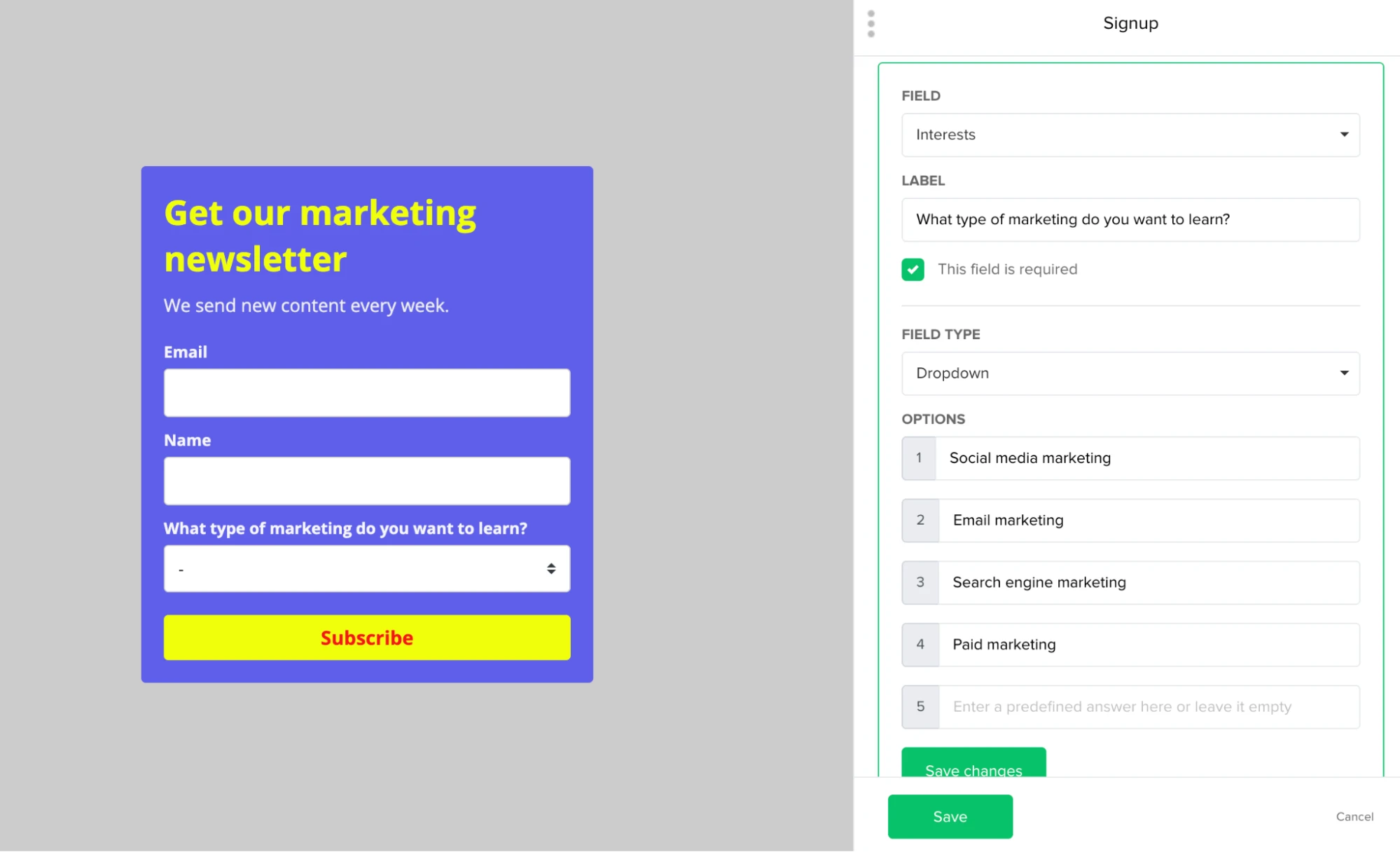
Any information the subscriber enters will be added to their profile. You can then use this to personalize the email content or to group and segment subscribers.
The subscriber’s name is probably the most common type of information to collect. But you can collect pretty much anything.
The key is to think about the information that will allow you to send more targeted or personal messages.
Here are some examples:
Birthday: Send a birthday discount
Interests: Send products they will like
Company size: Send more relevant content
The downside is that requesting too much information might stop people from signing up. Consider only asking for the most essential information. You can then use the methods below to collect further details once the subscriber joins your list.
2. Use automations to tag or group subscribers
Using automations to tag or group subscribers is a good way to collect information you can use to personalize emails. Since this happens automatically, it isn’t reliant on the subscriber actively providing data.
Subscriber actions you can use to tag or group subscribers include:
Filling in a form
Clicking a link
Opening an email
In the example below, when a subscriber clicks on a link to a store’s golf collection, the automation updates the Interests field to include “Golf” and then adds them to a group for people interested in “Golf.”
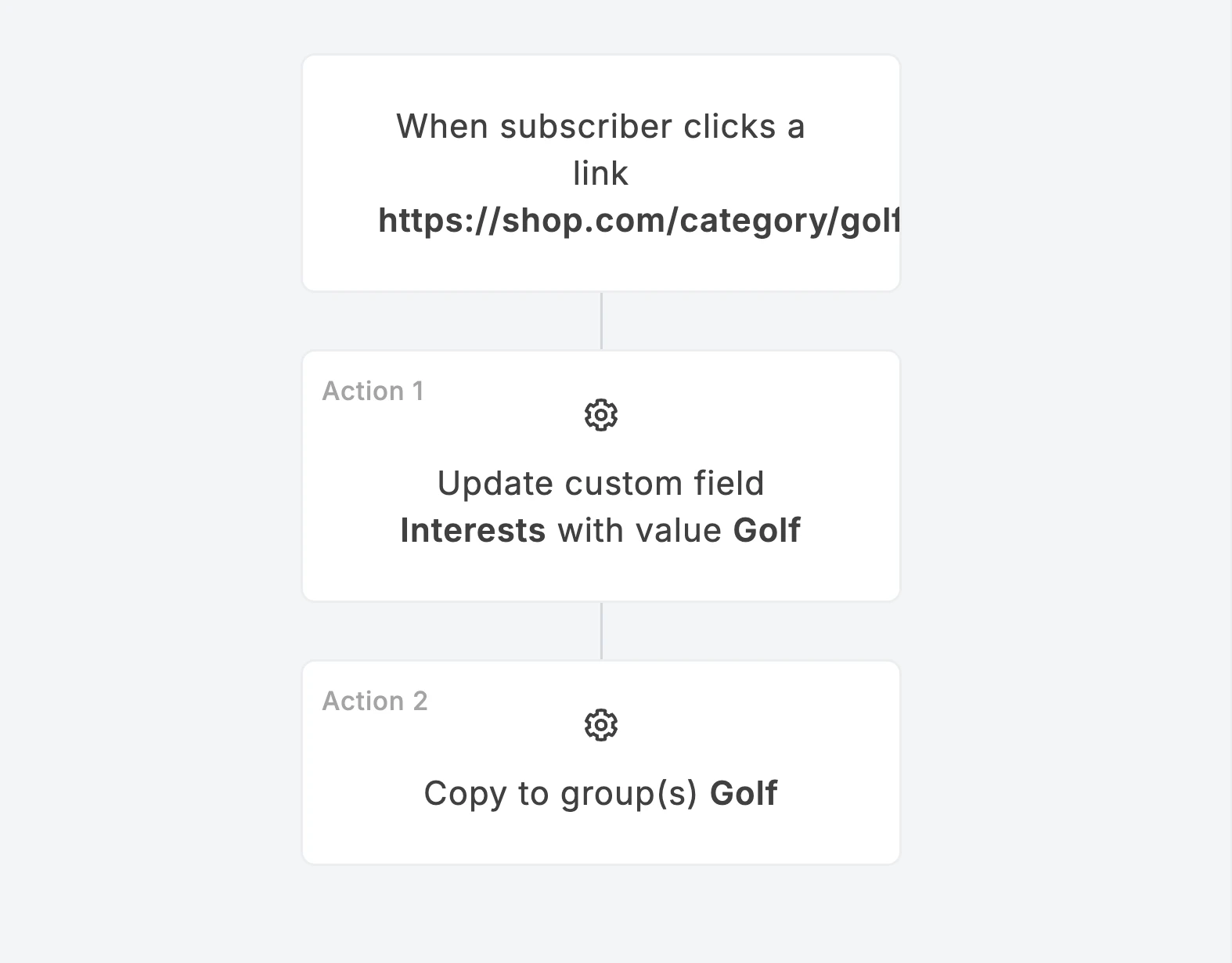
You can then use this information to send personalized content, such as offers around golf products.
3. Create segments based on email engagement
Email marketing segmentation lets you create lists of subscribers based on factors like engagement.
This lets you manually segment subscribers based on actions they have already taken. You can create segments based on tons of automatically collected data, including:
Specific links clicked
Specific emails opened
Percentage of emails opened or clicked
Time zone and location
Sign up source and date
Just head to the Subscribers section of your dashboard and then use the filters to narrow down to your chosen subscribers.
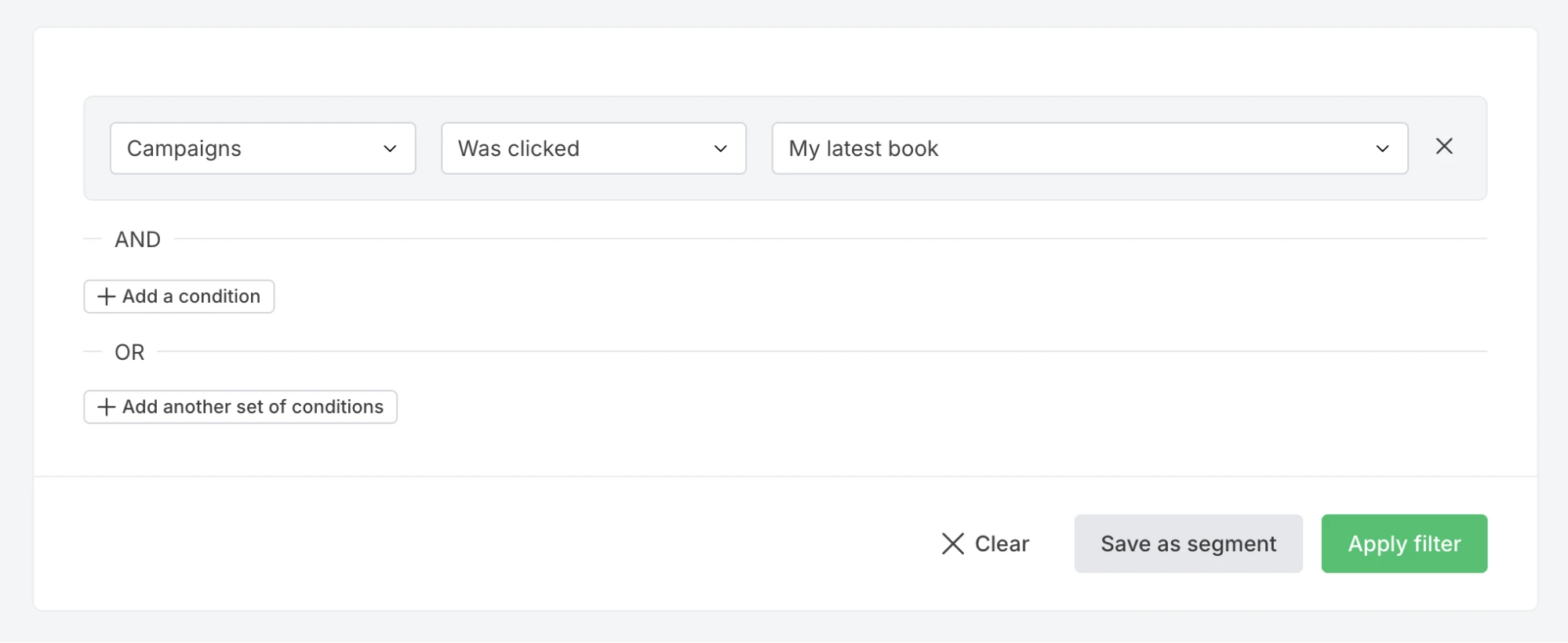
You can then click Save as segment to save the chosen subscribers into a specific segment.
4. Send surveys to gather data
Email surveys are a good way to collect information that you can’t collect automatically. Since the person is already on your email list, it’s safe to ask for more information than on your signup form.
MailerLite lets you create and embed surveys in any email. This can be anything from a single-question poll to a more comprehensive survey.
To start, drag and drop the survey block into your email. You can then add your questions. Finally, use the Rules section of the survey to add subscribers to groups or update custom fields based on their answers.
For example, the survey in the screenshot uses rules to update the Interests field with the option the user selects. You could use information to add dynamic content to emails or send targeted email marketing campaigns.
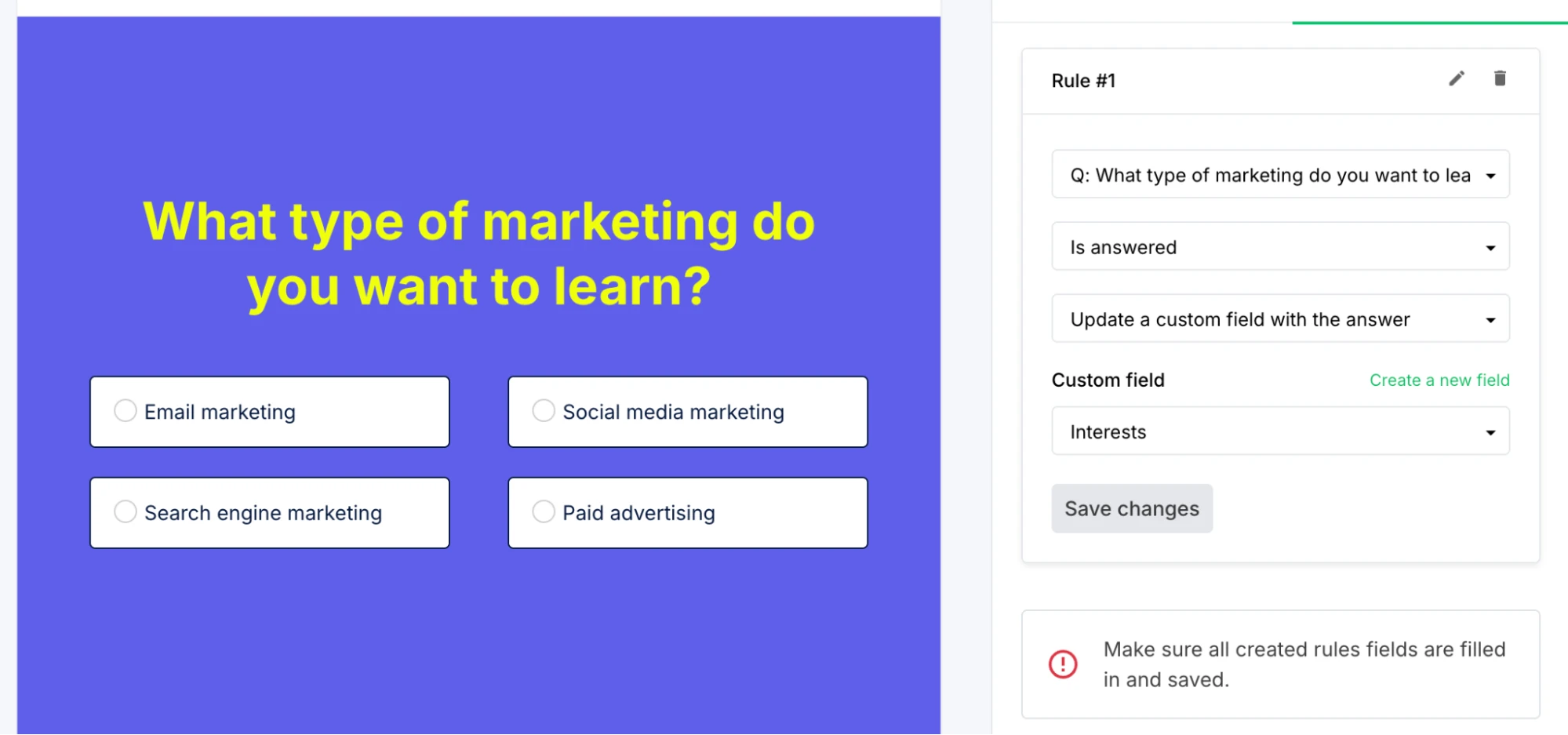
5. Use data from integrated tools
Use data from integrated tools to segment, group or tag subscribers.
For example, when you connect one of our e-commerce integrations, we’ll automatically sync data such as their order count and total spend. You can also use automations to group or tag subscribers based on the products and categories they buy.
Other tools also bring in their own relevant data. Membership tools will provide information about the plan level, while referral tools can provide data on who makes referrals.
It all depends on the tool and the information it collects.
6. Use a preference center
Your final option to power your email personalization strategies is to add a preference center to your emails. Subscribers can use this to tell you more about them.
Preference centers work in a similar way to surveys and forms: You can add fields that the subscriber can use to change or provide more information, as well as add questions that you can then use rules to update fields or group subscribers.
The question below lets subscribers tell the newsletter that they are interested in social media marketing, email marketing, search engine marketing or paid ads. You could use this knowledge to send more relevant content and offers.
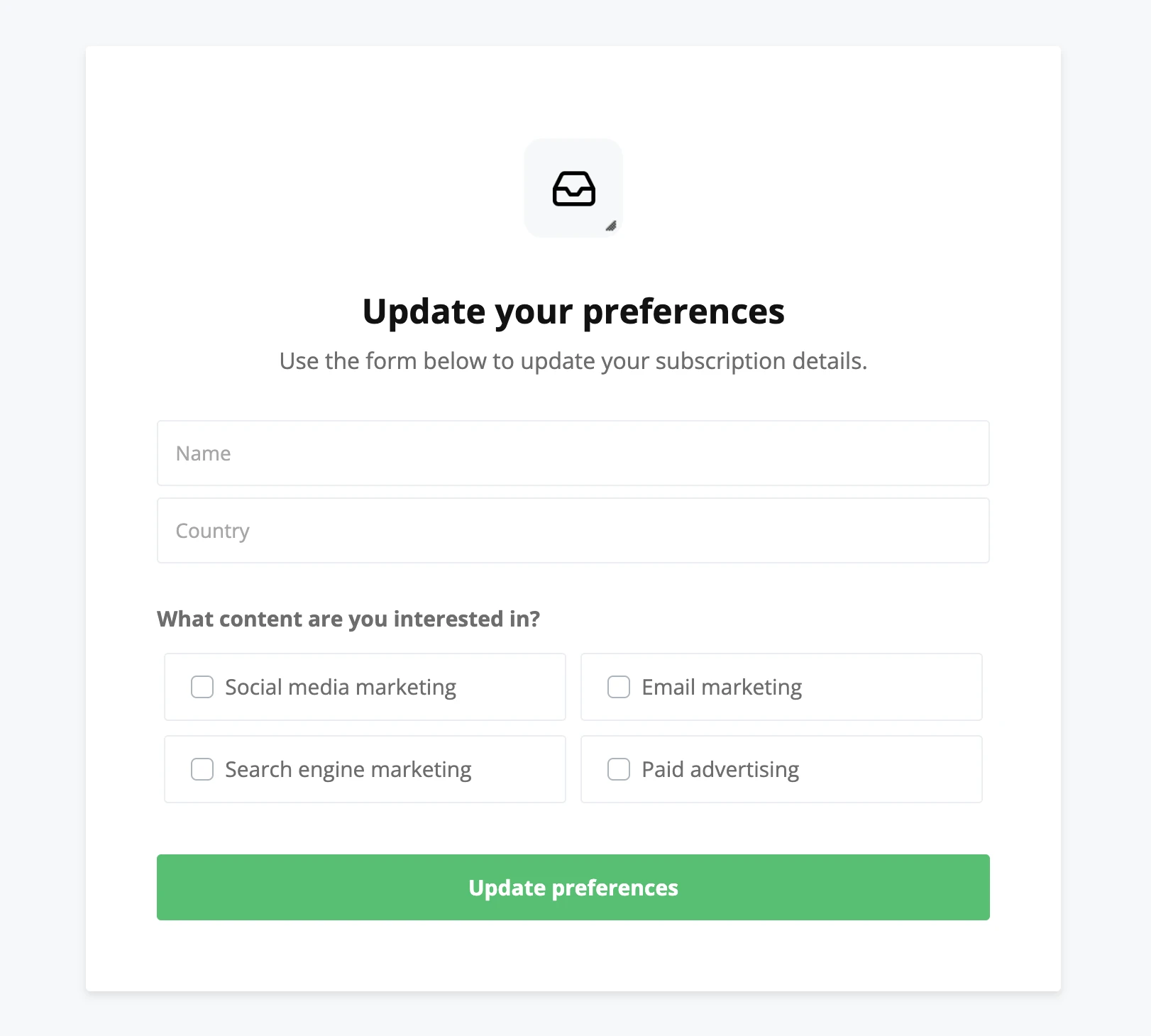
How to make your email feel even more personal
So far, we’ve focused on personalizing the email to each subscriber’s needs. But there are also steps you can take to make your email feel like it is coming from a real person rather than a brand. This can make it seem even more like a personal message.
1. Include a real name and photo
A personalized email should come from a real person. The best way to humanize your email is to include a photo of the sender. People are visual, and a photo will make an instant connection.
2. Show your personality
Try to avoid business jargon. Talk in a friendly, more conversational manner. Your brand should have a distinct personality. Email is a great place to showcase it. Engaging personalities draw in people.
3. Make it easy to respond
A two-way relationship means people should be able to reply directly to the sender. Make sure the email address includes the sender’s name and put a process in place to respond promptly. Also, set up a fun, eye-catching call-to-action (CTA), so that they can dig deeper.
4. Personalize the sender name and address
When the email comes from a real person instead of a disembodied company, it adds a human touch that is harder to ignore.
Consider using a personal email address like yourname@yourbusiness.com rather than a generic one like contact@yourbusiness.com.
You can also add your real name to the from field rather than the name of your business. We recently tested adding a name when sending our MailerLite newsletter and this simple change resulted in a 3.81% increase in open rates.
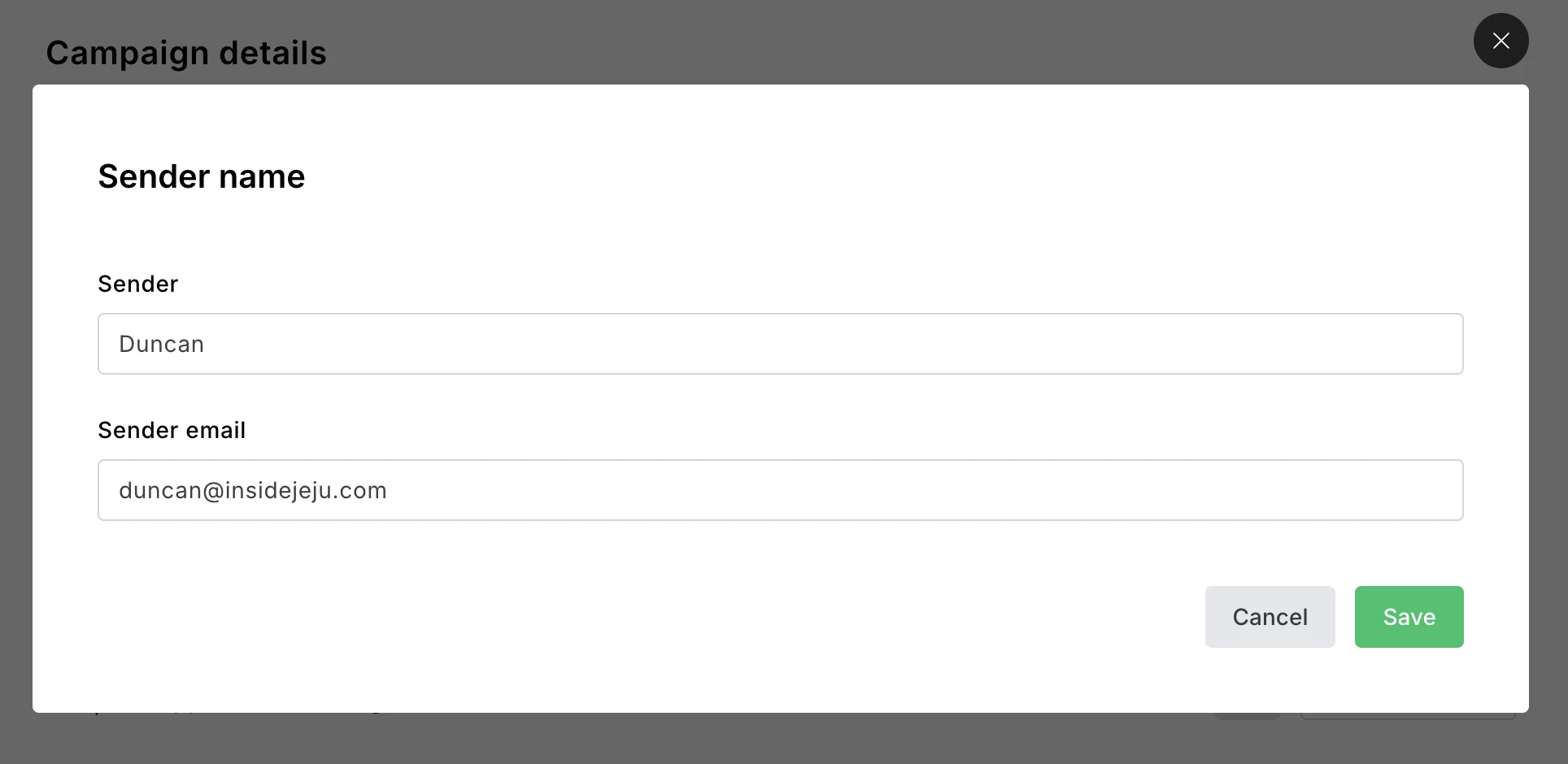
5. BIMI company logo
BIMI is an email standard that allows you to have your company logo show up in the recipient’s inbox next to any emails sent from your domain.
It helps your emails be more visible in the inbox, builds trust and can result in a more personal feeling email than if you just had the generic inbox logo.
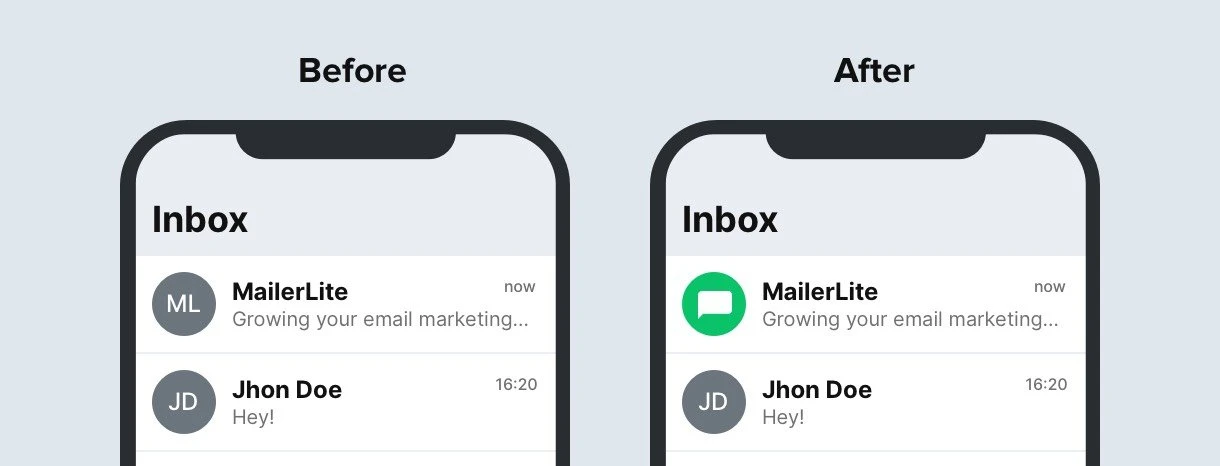
Plus, setting up BIMI is more accessible than ever before. Find out how you can get started in our guide to BIMI.
Personalized email examples done right
It’s inspiration time! As these 4 examples will show, there’s more than one way to personalize your email…
1. Spotify's year in review
Now, the obvious choice might be to whack your subscriber’s name in the subject line, but Spotify went deeper in this personalized email. They dug into their customer data and delivered an end-of-year review of everyone’s listening history. Digital marketing at its finest!

2. Uber Eats' re-engagement email
In this personalized re-engagement email, Uber Eats segmented their subscribers and targeted the ones who hadn't made a purchase in a while - ‘We’ve missed you Erin!’. The content is relevant to those who previously used their service, but haven’t been using it as frequently, and offers an incentive to make another purchase.
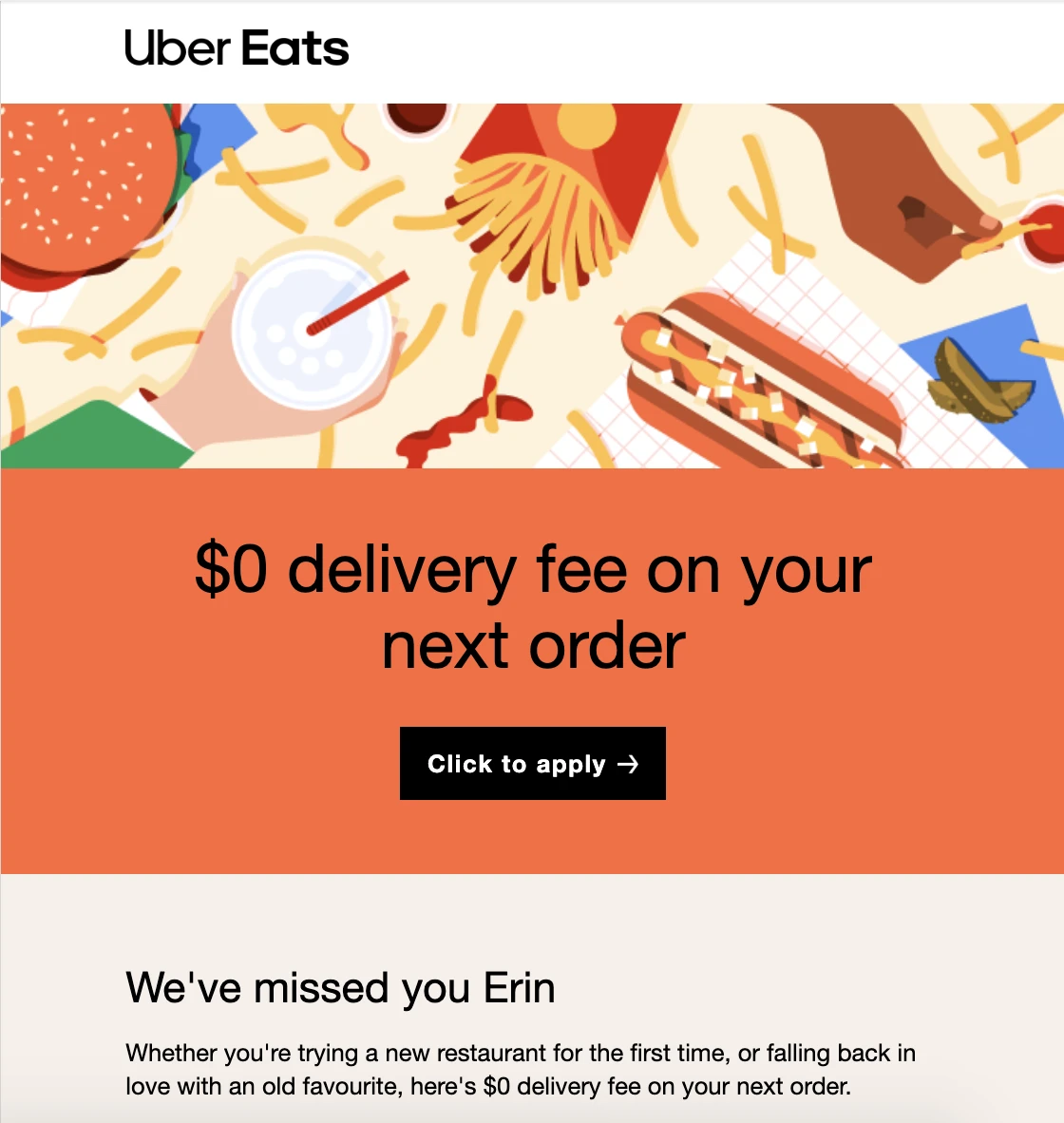
3. Grammarly's weekly writing insights
Grammarly provides users with weekly metrics that provide insight into their writing. This includes handy stats like most common mistakes and tones used that help users adjust their writing to help meet their objectives.
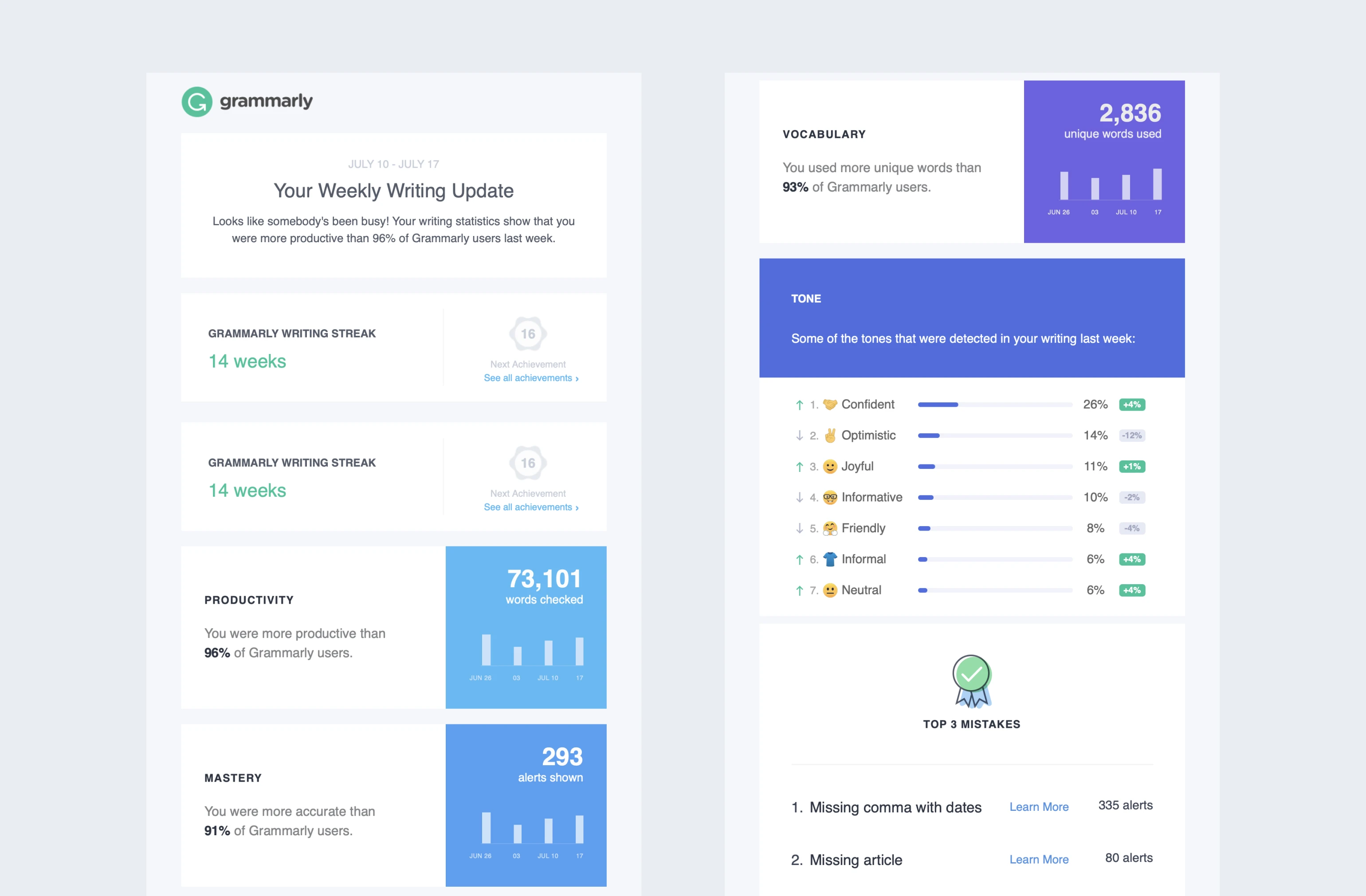
4. Google’s timeline update
When people have their location history switched on, Google sends a yearly newsletter showing the places they visited and where they spent most of their time. A nice way for people to look back on how far they’ve come (literally)!
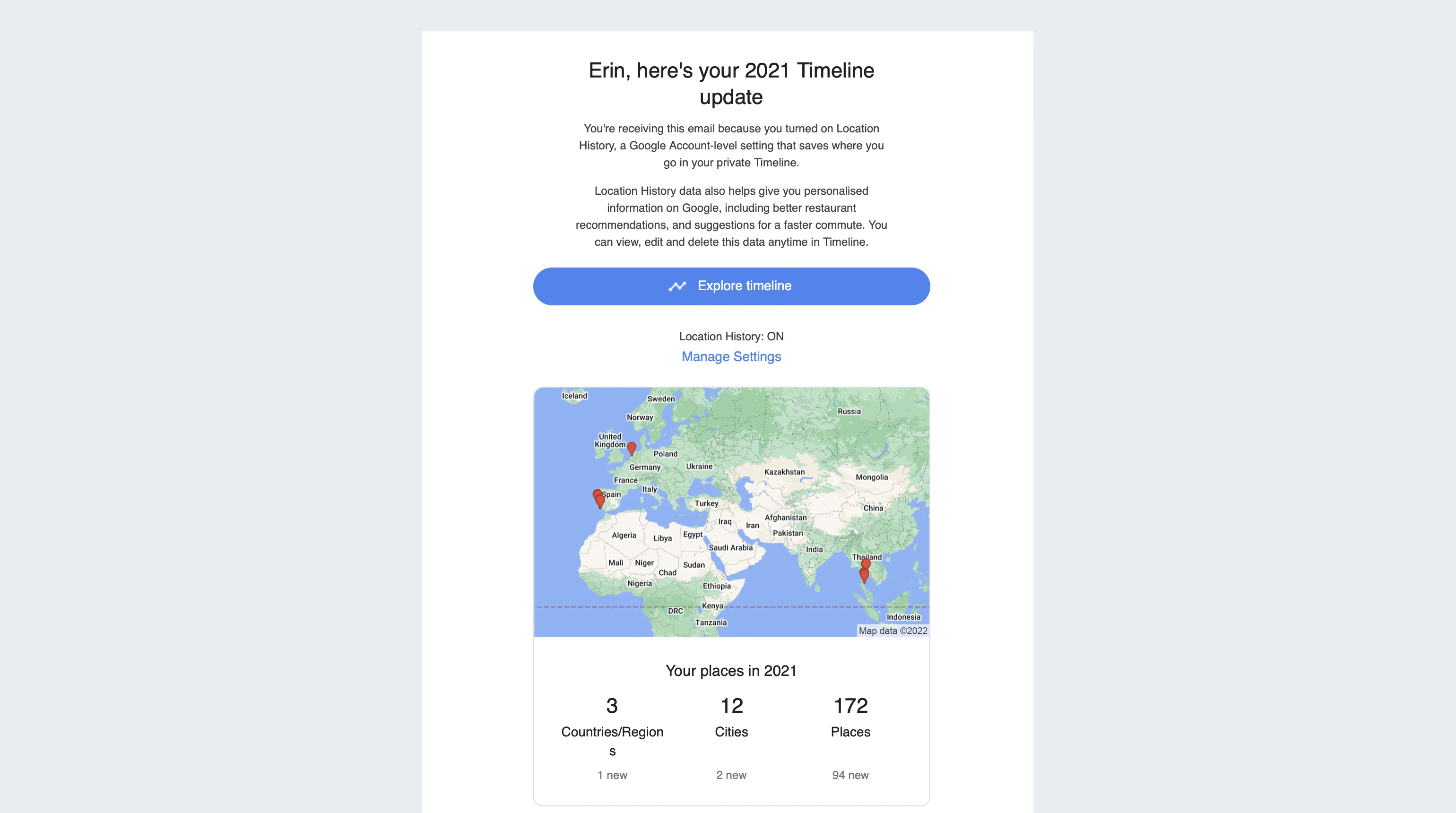
(P.S. For more stunning newsletter ideas, check out our email template gallery! 😍 )
Let's get personal
MailerLite makes it easy for you to create personalized experiences for your subscribers. Get it right and you’ll send effective emails that boost your marketing efforts.
The key is to identify the types of data that will be useful for your personalization efforts and then use this information to send emails tailored to each subscriber’s specific needs.
Access powerful personalization tools today
Join MailerLite to start sending personalized messages that result in sales. Start with a free trial to test all the tools mentioned in this article and much, much more.

